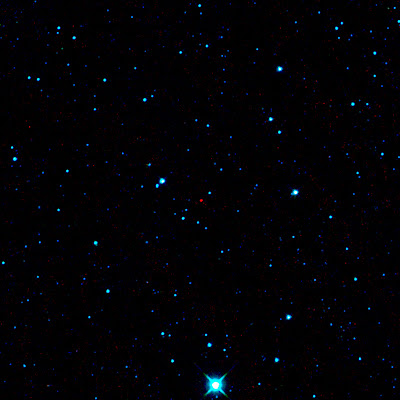The red dot at the center of this image is the first near-Earth asteroid discovered by NASA's Wide-Field Infrared Survey Explorer, or WISE -- an all-sky mapping infrared mission designed to see all sorts of cosmic objects.
Image credit: NASA/JPL-Caltech/UCLA
Near-Earth objects are asteroids and comets with orbits that come close to Earth's path around the sun. This particular asteroid, called 2010 AB78, is roughly one kilometer (0.6 miles) in diameter, and is currently about 158 million kilometers (98 million miles) away from Earth. Its elliptical-shaped orbit takes it out beyond Mars and back in about as close to the sun as Earth. Because the asteroid's orbit is tilted relative to the plane of our solar system, astronomers do not think it poses a hazard to our planet. As with all near-Earth objects, 2010 AB78 will continue to be monitored.
The image shows three infrared wavelengths, with red representing the longest wavelength of 12 microns, and green and blue showing 4.6- and 3.4-micron light, respectively. The asteroid appears redder than the rest of the background stars because it is cooler and emits most of its light at longer infrared wavelengths. In visible light, this space rock is very faint and difficult to see.
WISE, which began its all-sky survey on Jan. 14, 2010, is expected to find about one hundred thousand previously undiscovered asteroids in the Main Belt between Mars and Jupiter, and hundreds of new near-Earth asteroids. It will also spot millions of new stars and galaxies.
NASA's Wide-field Infrared Survey Explorer, or WISE, has spotted its first never-before-seen near-Earth asteroid, the first of hundreds it is expected to find during its mission to map the whole sky in infrared light.
The near-Earth object, designated 2010 AB78, was discovered by WISE Jan. 12. After the mission's sophisticated software picked out the moving object against a background of stationary stars, researchers followed up and confirmed the discovery with the University of Hawaii's 2.2-meter (88-inch) visible-light telescope near the summit of Mauna Kea.
The asteroid is currently about 158 million kilometers (98 million miles) from Earth. It is estimated to be roughly 1 kilometer (0.6 miles) in diameter and circles the sun in an elliptical orbit tilted to the plane of our solar system. The object comes as close to the sun as Earth, but because of its tilted orbit, it is not thought to pass near our planet. This asteroid does not pose any foreseeable impact threat to Earth, but scientists will continue to monitor it.
WISE, which began its all-sky survey on Jan. 14, is expected to find about 100-thousand previously undiscovered asteroids in the Main Belt between Mars and Jupiter, and hundreds of new near-Earth asteroids. It will also spot millions of new stars and galaxies.
NASA's Jet Propulsion Laboratory in Pasadena, Calif., manages the WISE for NASA's Science Mission Directorate, Washington. The principal investigator, Edward Wright, is at UCLA. The mission was competitively selected under NASA's Explorers Program managed by the Goddard Space Flight Center, Greenbelt, Md. The science instrument was built by the Space Dynamics Laboratory, Logan, Utah, and the spacecraft was built by Ball Aerospace & Technologies Corp., Boulder, Colo. Science operations and data processing take place at the Infrared Processing and Analysis Center at the California Institute of Technology in Pasadena. Caltech manages JPL for NASA. The ground-based observations are partly supported by the National Science Foundation.
More information is online at http://www.nasa.gov/wise , http://wise.astro.ucla.edu and http://jpl.nasa.gov/wise .
The near-Earth object, designated 2010 AB78, was discovered by WISE Jan. 12. After the mission's sophisticated software picked out the moving object against a background of stationary stars, researchers followed up and confirmed the discovery with the University of Hawaii's 2.2-meter (88-inch) visible-light telescope near the summit of Mauna Kea.
The asteroid is currently about 158 million kilometers (98 million miles) from Earth. It is estimated to be roughly 1 kilometer (0.6 miles) in diameter and circles the sun in an elliptical orbit tilted to the plane of our solar system. The object comes as close to the sun as Earth, but because of its tilted orbit, it is not thought to pass near our planet. This asteroid does not pose any foreseeable impact threat to Earth, but scientists will continue to monitor it.
WISE, which began its all-sky survey on Jan. 14, is expected to find about 100-thousand previously undiscovered asteroids in the Main Belt between Mars and Jupiter, and hundreds of new near-Earth asteroids. It will also spot millions of new stars and galaxies.
NASA's Jet Propulsion Laboratory in Pasadena, Calif., manages the WISE for NASA's Science Mission Directorate, Washington. The principal investigator, Edward Wright, is at UCLA. The mission was competitively selected under NASA's Explorers Program managed by the Goddard Space Flight Center, Greenbelt, Md. The science instrument was built by the Space Dynamics Laboratory, Logan, Utah, and the spacecraft was built by Ball Aerospace & Technologies Corp., Boulder, Colo. Science operations and data processing take place at the Infrared Processing and Analysis Center at the California Institute of Technology in Pasadena. Caltech manages JPL for NASA. The ground-based observations are partly supported by the National Science Foundation.
More information is online at http://www.nasa.gov/wise , http://wise.astro.ucla.edu and http://jpl.nasa.gov/wise .
Whitney Clavin 818-354-4673
Jet Propulsion Laboratory, Pasadena, Calif.
whitney.clavin@jpl.nasa.gov
Jet Propulsion Laboratory, Pasadena, Calif.
whitney.clavin@jpl.nasa.gov




